Changes Made to National Marketing Strategy to Suit Local Culture
VerifiedAdded on 2023/06/03
|14
|2995
|223
AI Summary
This article discusses the changes made to national marketing strategy to suit local culture in international marketing. It covers the theory of Geert Hofstede and the cultural differences between China and the United States. It also explores the developments in international businesses and the importance of understanding market-specific strategies.
Contribute Materials
Your contribution can guide someone’s learning journey. Share your
documents today.
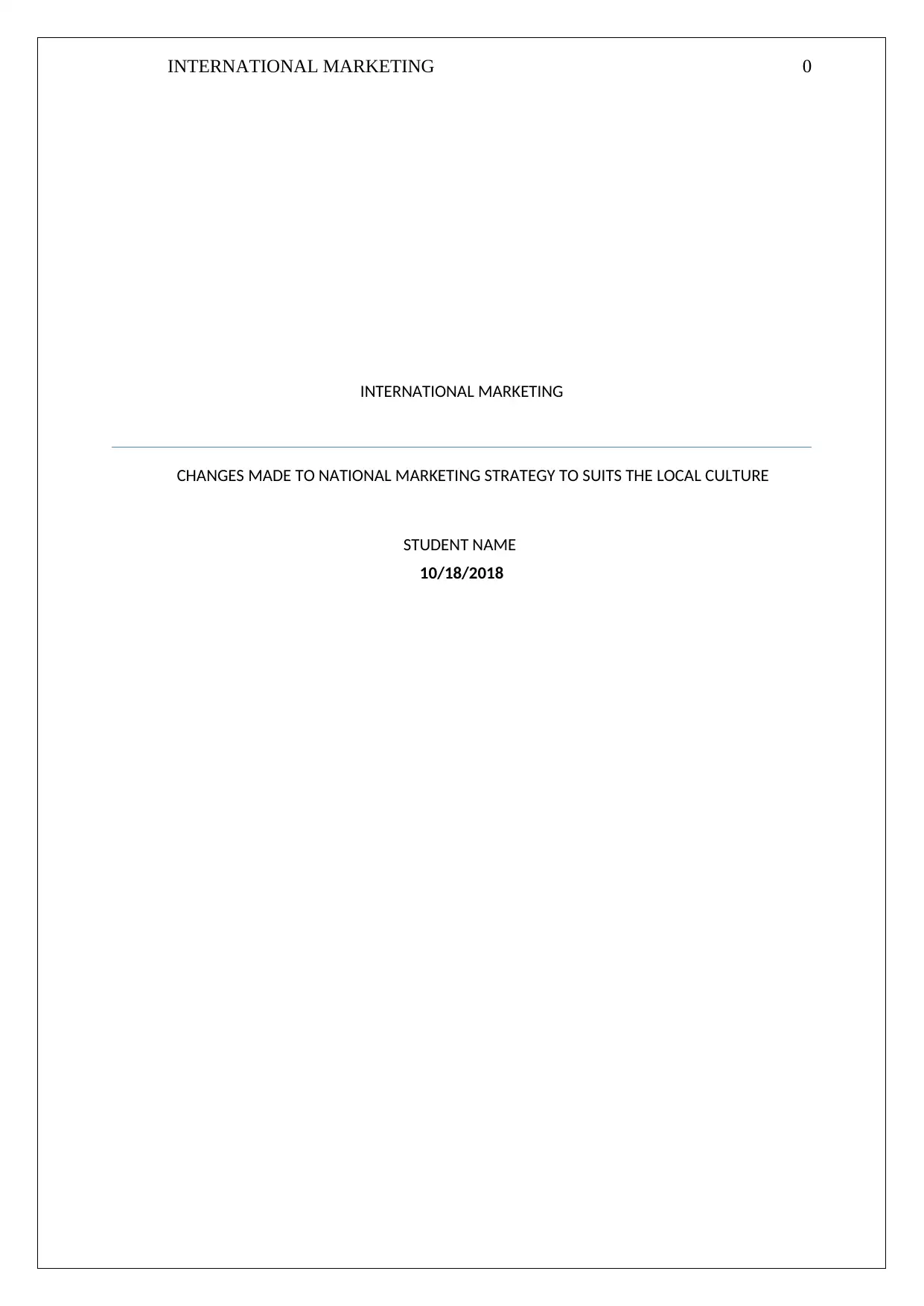
INTERNATIONAL MARKETING 0
INTERNATIONAL MARKETING
CHANGES MADE TO NATIONAL MARKETING STRATEGY TO SUITS THE LOCAL CULTURE
STUDENT NAME
10/18/2018
INTERNATIONAL MARKETING
CHANGES MADE TO NATIONAL MARKETING STRATEGY TO SUITS THE LOCAL CULTURE
STUDENT NAME
10/18/2018
Secure Best Marks with AI Grader
Need help grading? Try our AI Grader for instant feedback on your assignments.
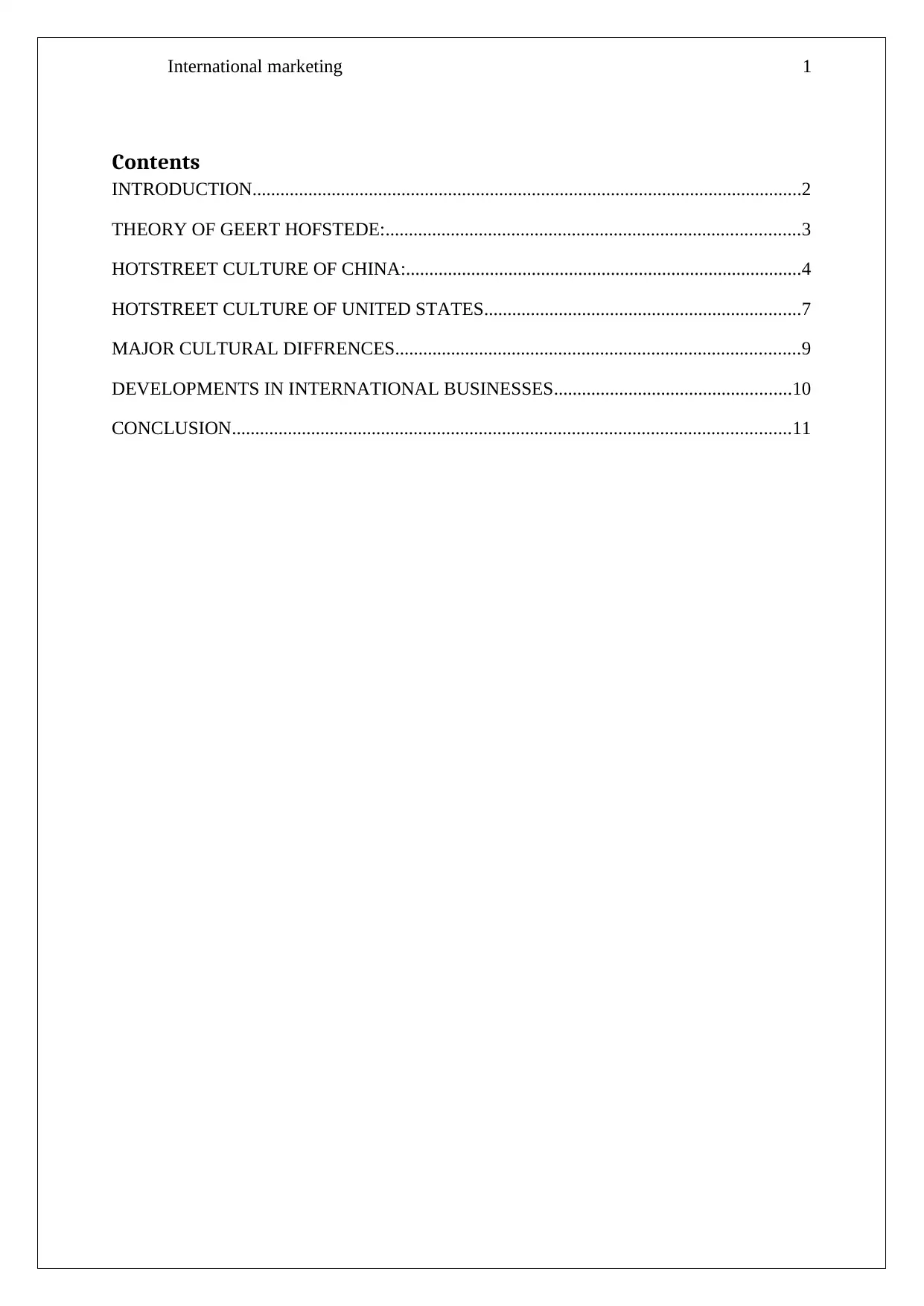
International marketing 1
Contents
INTRODUCTION......................................................................................................................2
THEORY OF GEERT HOFSTEDE:.........................................................................................3
HOTSTREET CULTURE OF CHINA:.....................................................................................4
HOTSTREET CULTURE OF UNITED STATES....................................................................7
MAJOR CULTURAL DIFFRENCES.......................................................................................9
DEVELOPMENTS IN INTERNATIONAL BUSINESSES...................................................10
CONCLUSION........................................................................................................................11
Contents
INTRODUCTION......................................................................................................................2
THEORY OF GEERT HOFSTEDE:.........................................................................................3
HOTSTREET CULTURE OF CHINA:.....................................................................................4
HOTSTREET CULTURE OF UNITED STATES....................................................................7
MAJOR CULTURAL DIFFRENCES.......................................................................................9
DEVELOPMENTS IN INTERNATIONAL BUSINESSES...................................................10
CONCLUSION........................................................................................................................11
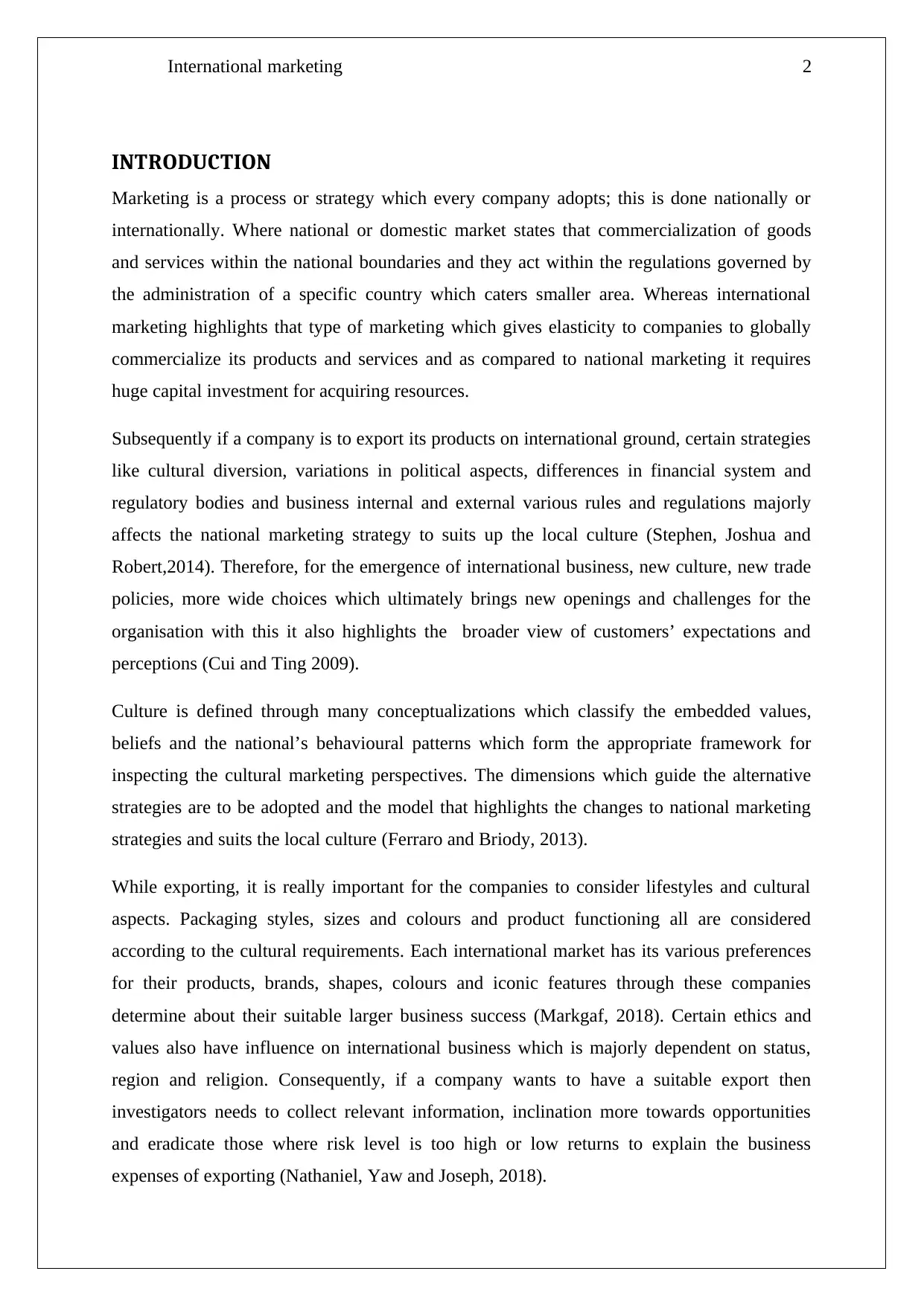
International marketing 2
INTRODUCTION
Marketing is a process or strategy which every company adopts; this is done nationally or
internationally. Where national or domestic market states that commercialization of goods
and services within the national boundaries and they act within the regulations governed by
the administration of a specific country which caters smaller area. Whereas international
marketing highlights that type of marketing which gives elasticity to companies to globally
commercialize its products and services and as compared to national marketing it requires
huge capital investment for acquiring resources.
Subsequently if a company is to export its products on international ground, certain strategies
like cultural diversion, variations in political aspects, differences in financial system and
regulatory bodies and business internal and external various rules and regulations majorly
affects the national marketing strategy to suits up the local culture (Stephen, Joshua and
Robert,2014). Therefore, for the emergence of international business, new culture, new trade
policies, more wide choices which ultimately brings new openings and challenges for the
organisation with this it also highlights the broader view of customers’ expectations and
perceptions (Cui and Ting 2009).
Culture is defined through many conceptualizations which classify the embedded values,
beliefs and the national’s behavioural patterns which form the appropriate framework for
inspecting the cultural marketing perspectives. The dimensions which guide the alternative
strategies are to be adopted and the model that highlights the changes to national marketing
strategies and suits the local culture (Ferraro and Briody, 2013).
While exporting, it is really important for the companies to consider lifestyles and cultural
aspects. Packaging styles, sizes and colours and product functioning all are considered
according to the cultural requirements. Each international market has its various preferences
for their products, brands, shapes, colours and iconic features through these companies
determine about their suitable larger business success (Markgaf, 2018). Certain ethics and
values also have influence on international business which is majorly dependent on status,
region and religion. Consequently, if a company wants to have a suitable export then
investigators needs to collect relevant information, inclination more towards opportunities
and eradicate those where risk level is too high or low returns to explain the business
expenses of exporting (Nathaniel, Yaw and Joseph, 2018).
INTRODUCTION
Marketing is a process or strategy which every company adopts; this is done nationally or
internationally. Where national or domestic market states that commercialization of goods
and services within the national boundaries and they act within the regulations governed by
the administration of a specific country which caters smaller area. Whereas international
marketing highlights that type of marketing which gives elasticity to companies to globally
commercialize its products and services and as compared to national marketing it requires
huge capital investment for acquiring resources.
Subsequently if a company is to export its products on international ground, certain strategies
like cultural diversion, variations in political aspects, differences in financial system and
regulatory bodies and business internal and external various rules and regulations majorly
affects the national marketing strategy to suits up the local culture (Stephen, Joshua and
Robert,2014). Therefore, for the emergence of international business, new culture, new trade
policies, more wide choices which ultimately brings new openings and challenges for the
organisation with this it also highlights the broader view of customers’ expectations and
perceptions (Cui and Ting 2009).
Culture is defined through many conceptualizations which classify the embedded values,
beliefs and the national’s behavioural patterns which form the appropriate framework for
inspecting the cultural marketing perspectives. The dimensions which guide the alternative
strategies are to be adopted and the model that highlights the changes to national marketing
strategies and suits the local culture (Ferraro and Briody, 2013).
While exporting, it is really important for the companies to consider lifestyles and cultural
aspects. Packaging styles, sizes and colours and product functioning all are considered
according to the cultural requirements. Each international market has its various preferences
for their products, brands, shapes, colours and iconic features through these companies
determine about their suitable larger business success (Markgaf, 2018). Certain ethics and
values also have influence on international business which is majorly dependent on status,
region and religion. Consequently, if a company wants to have a suitable export then
investigators needs to collect relevant information, inclination more towards opportunities
and eradicate those where risk level is too high or low returns to explain the business
expenses of exporting (Nathaniel, Yaw and Joseph, 2018).
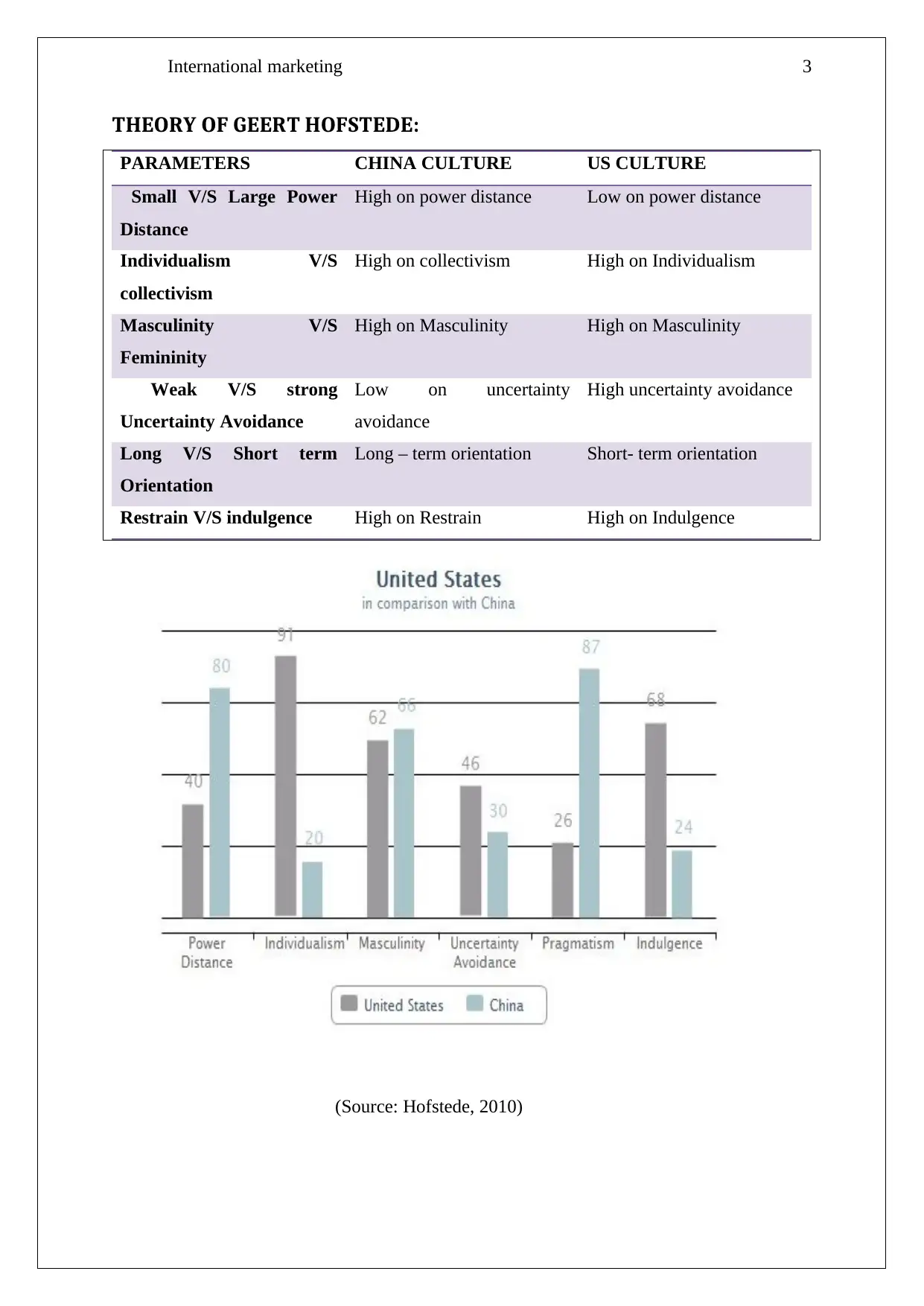
International marketing 3
THEORY OF GEERT HOFSTEDE:
PARAMETERS CHINA CULTURE US CULTURE
Small V/S Large Power
Distance
High on power distance Low on power distance
Individualism V/S
collectivism
High on collectivism High on Individualism
Masculinity V/S
Femininity
High on Masculinity High on Masculinity
Weak V/S strong
Uncertainty Avoidance
Low on uncertainty
avoidance
High uncertainty avoidance
Long V/S Short term
Orientation
Long – term orientation Short- term orientation
Restrain V/S indulgence High on Restrain High on Indulgence
(Source: Hofstede, 2010)
THEORY OF GEERT HOFSTEDE:
PARAMETERS CHINA CULTURE US CULTURE
Small V/S Large Power
Distance
High on power distance Low on power distance
Individualism V/S
collectivism
High on collectivism High on Individualism
Masculinity V/S
Femininity
High on Masculinity High on Masculinity
Weak V/S strong
Uncertainty Avoidance
Low on uncertainty
avoidance
High uncertainty avoidance
Long V/S Short term
Orientation
Long – term orientation Short- term orientation
Restrain V/S indulgence High on Restrain High on Indulgence
(Source: Hofstede, 2010)
Secure Best Marks with AI Grader
Need help grading? Try our AI Grader for instant feedback on your assignments.
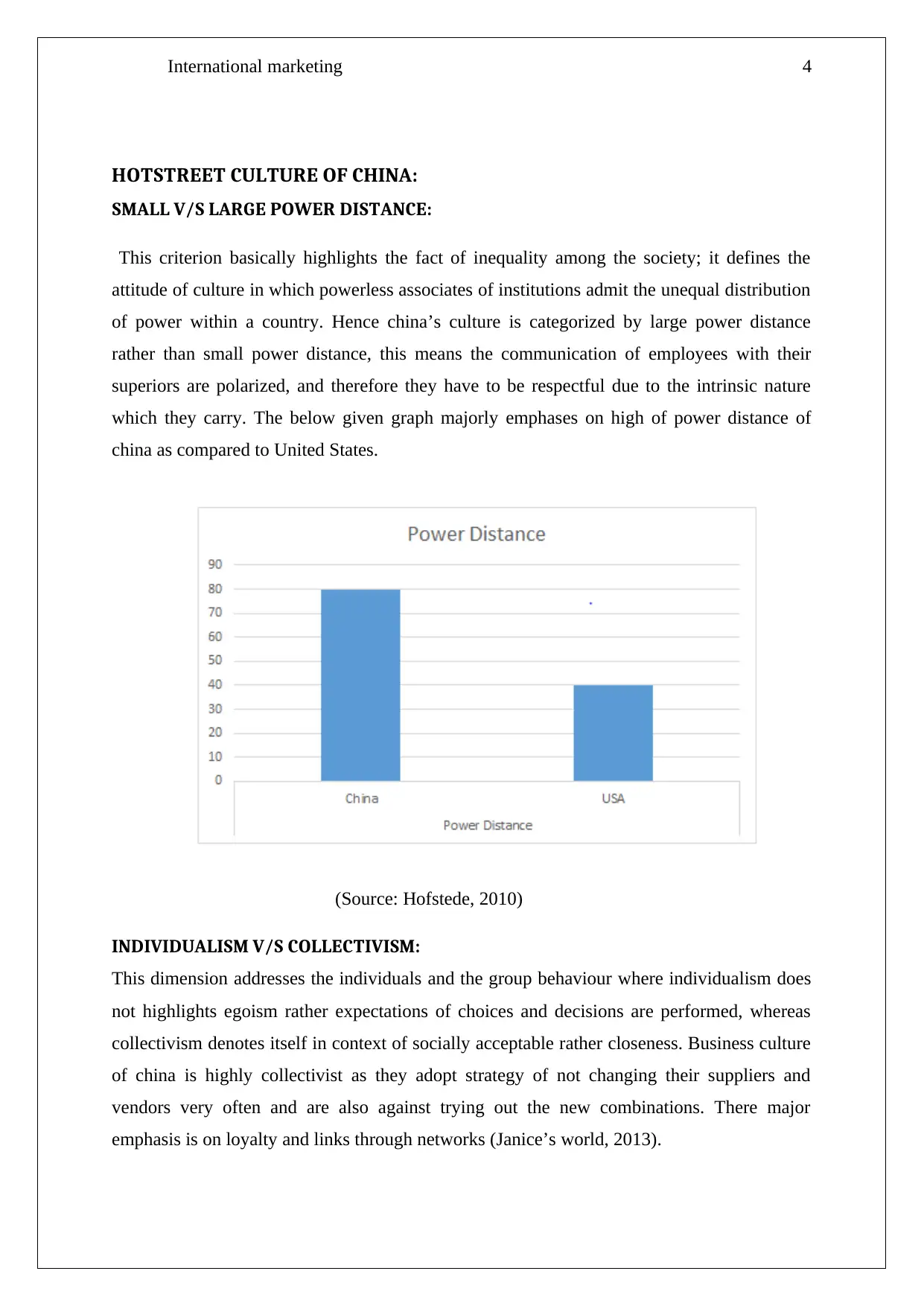
International marketing 4
HOTSTREET CULTURE OF CHINA:
SMALL V/S LARGE POWER DISTANCE:
This criterion basically highlights the fact of inequality among the society; it defines the
attitude of culture in which powerless associates of institutions admit the unequal distribution
of power within a country. Hence china’s culture is categorized by large power distance
rather than small power distance, this means the communication of employees with their
superiors are polarized, and therefore they have to be respectful due to the intrinsic nature
which they carry. The below given graph majorly emphases on high of power distance of
china as compared to United States.
(Source: Hofstede, 2010)
INDIVIDUALISM V/S COLLECTIVISM:
This dimension addresses the individuals and the group behaviour where individualism does
not highlights egoism rather expectations of choices and decisions are performed, whereas
collectivism denotes itself in context of socially acceptable rather closeness. Business culture
of china is highly collectivist as they adopt strategy of not changing their suppliers and
vendors very often and are also against trying out the new combinations. There major
emphasis is on loyalty and links through networks (Janice’s world, 2013).
HOTSTREET CULTURE OF CHINA:
SMALL V/S LARGE POWER DISTANCE:
This criterion basically highlights the fact of inequality among the society; it defines the
attitude of culture in which powerless associates of institutions admit the unequal distribution
of power within a country. Hence china’s culture is categorized by large power distance
rather than small power distance, this means the communication of employees with their
superiors are polarized, and therefore they have to be respectful due to the intrinsic nature
which they carry. The below given graph majorly emphases on high of power distance of
china as compared to United States.
(Source: Hofstede, 2010)
INDIVIDUALISM V/S COLLECTIVISM:
This dimension addresses the individuals and the group behaviour where individualism does
not highlights egoism rather expectations of choices and decisions are performed, whereas
collectivism denotes itself in context of socially acceptable rather closeness. Business culture
of china is highly collectivist as they adopt strategy of not changing their suppliers and
vendors very often and are also against trying out the new combinations. There major
emphasis is on loyalty and links through networks (Janice’s world, 2013).
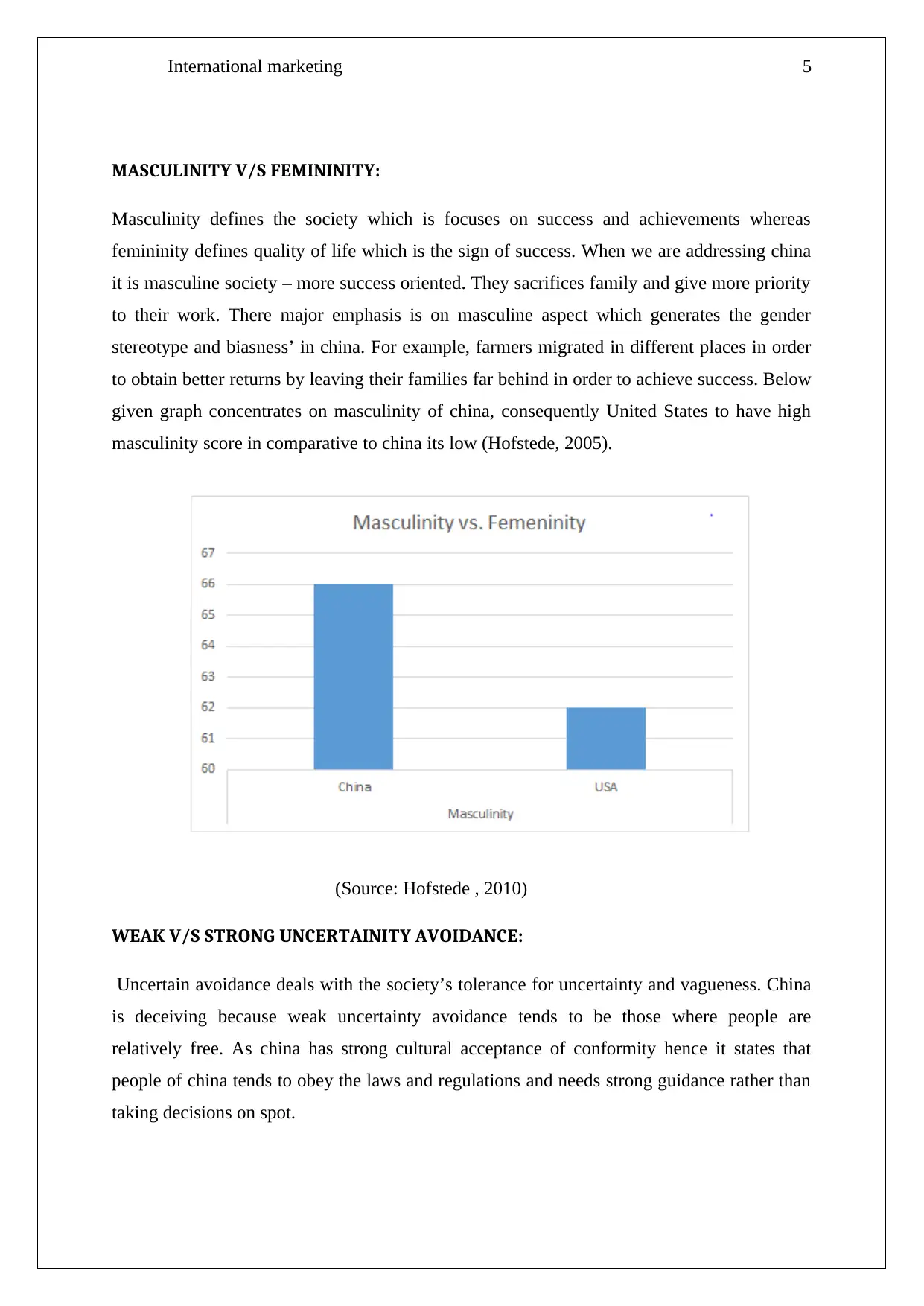
International marketing 5
MASCULINITY V/S FEMININITY:
Masculinity defines the society which is focuses on success and achievements whereas
femininity defines quality of life which is the sign of success. When we are addressing china
it is masculine society – more success oriented. They sacrifices family and give more priority
to their work. There major emphasis is on masculine aspect which generates the gender
stereotype and biasness’ in china. For example, farmers migrated in different places in order
to obtain better returns by leaving their families far behind in order to achieve success. Below
given graph concentrates on masculinity of china, consequently United States to have high
masculinity score in comparative to china its low (Hofstede, 2005).
(Source: Hofstede , 2010)
WEAK V/S STRONG UNCERTAINITY AVOIDANCE:
Uncertain avoidance deals with the society’s tolerance for uncertainty and vagueness. China
is deceiving because weak uncertainty avoidance tends to be those where people are
relatively free. As china has strong cultural acceptance of conformity hence it states that
people of china tends to obey the laws and regulations and needs strong guidance rather than
taking decisions on spot.
MASCULINITY V/S FEMININITY:
Masculinity defines the society which is focuses on success and achievements whereas
femininity defines quality of life which is the sign of success. When we are addressing china
it is masculine society – more success oriented. They sacrifices family and give more priority
to their work. There major emphasis is on masculine aspect which generates the gender
stereotype and biasness’ in china. For example, farmers migrated in different places in order
to obtain better returns by leaving their families far behind in order to achieve success. Below
given graph concentrates on masculinity of china, consequently United States to have high
masculinity score in comparative to china its low (Hofstede, 2005).
(Source: Hofstede , 2010)
WEAK V/S STRONG UNCERTAINITY AVOIDANCE:
Uncertain avoidance deals with the society’s tolerance for uncertainty and vagueness. China
is deceiving because weak uncertainty avoidance tends to be those where people are
relatively free. As china has strong cultural acceptance of conformity hence it states that
people of china tends to obey the laws and regulations and needs strong guidance rather than
taking decisions on spot.
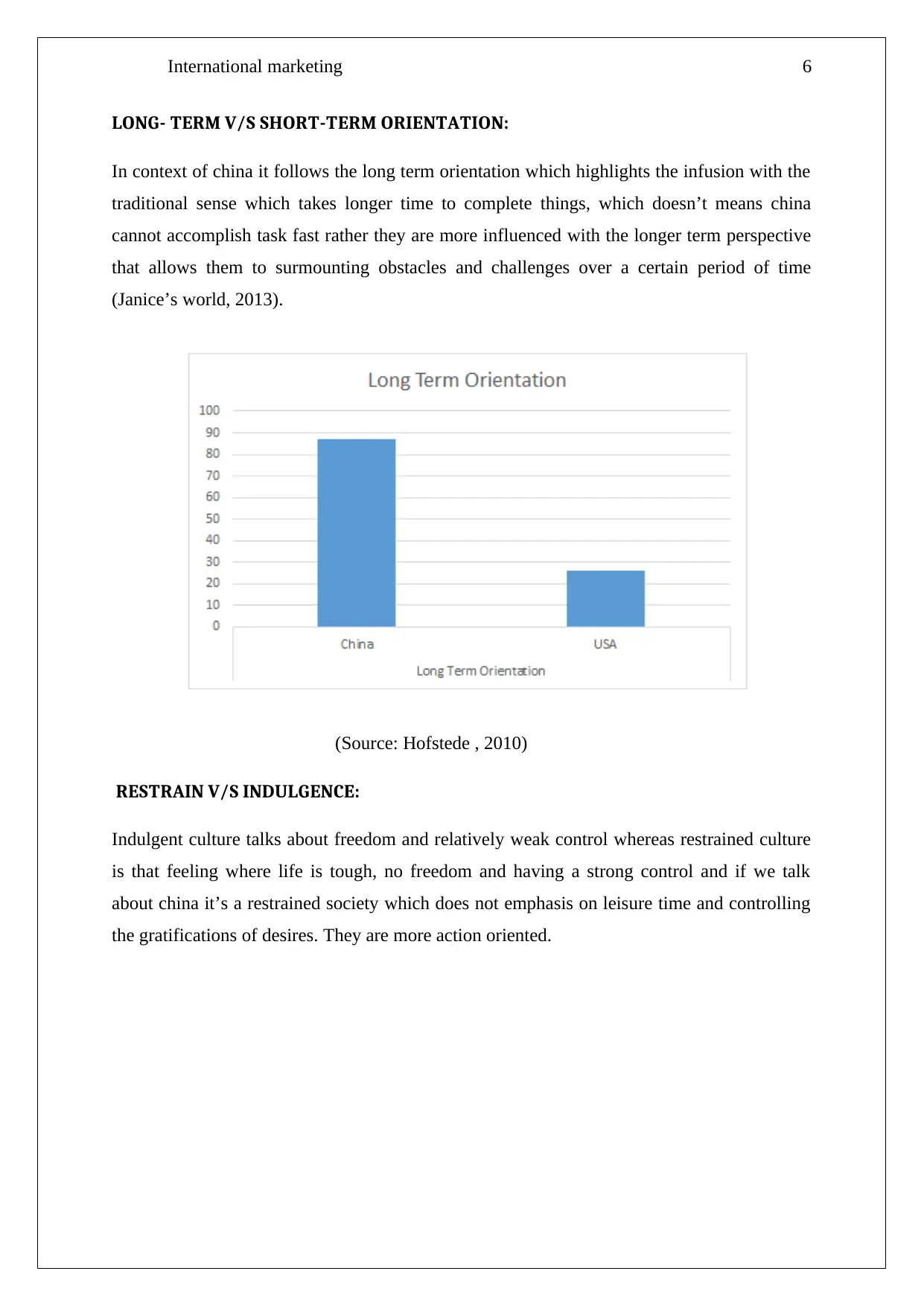
International marketing 6
LONG- TERM V/S SHORT-TERM ORIENTATION:
In context of china it follows the long term orientation which highlights the infusion with the
traditional sense which takes longer time to complete things, which doesn’t means china
cannot accomplish task fast rather they are more influenced with the longer term perspective
that allows them to surmounting obstacles and challenges over a certain period of time
(Janice’s world, 2013).
(Source: Hofstede , 2010)
RESTRAIN V/S INDULGENCE:
Indulgent culture talks about freedom and relatively weak control whereas restrained culture
is that feeling where life is tough, no freedom and having a strong control and if we talk
about china it’s a restrained society which does not emphasis on leisure time and controlling
the gratifications of desires. They are more action oriented.
LONG- TERM V/S SHORT-TERM ORIENTATION:
In context of china it follows the long term orientation which highlights the infusion with the
traditional sense which takes longer time to complete things, which doesn’t means china
cannot accomplish task fast rather they are more influenced with the longer term perspective
that allows them to surmounting obstacles and challenges over a certain period of time
(Janice’s world, 2013).
(Source: Hofstede , 2010)
RESTRAIN V/S INDULGENCE:
Indulgent culture talks about freedom and relatively weak control whereas restrained culture
is that feeling where life is tough, no freedom and having a strong control and if we talk
about china it’s a restrained society which does not emphasis on leisure time and controlling
the gratifications of desires. They are more action oriented.
Paraphrase This Document
Need a fresh take? Get an instant paraphrase of this document with our AI Paraphraser
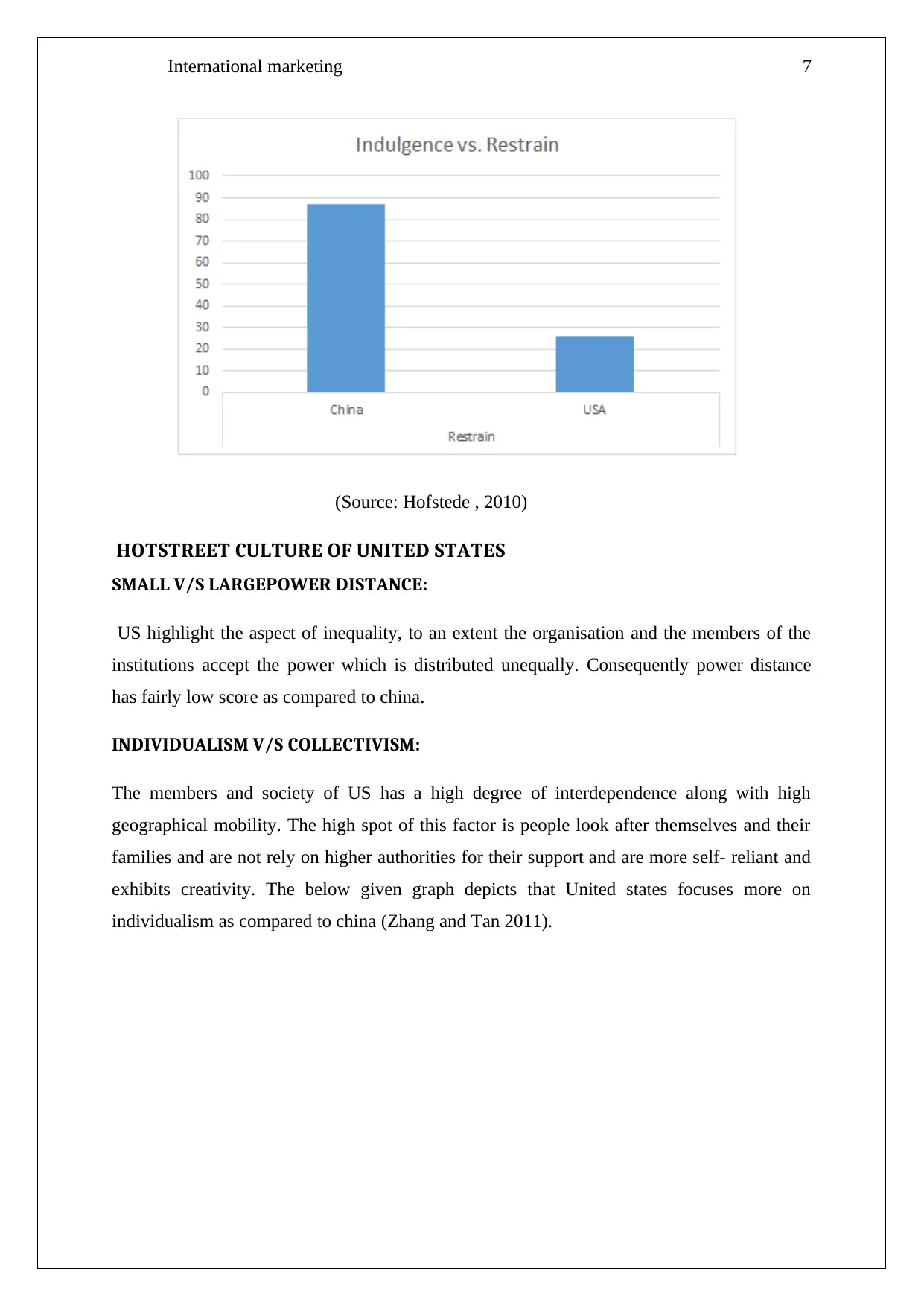
International marketing 7
(Source: Hofstede , 2010)
HOTSTREET CULTURE OF UNITED STATES
SMALL V/S LARGEPOWER DISTANCE:
US highlight the aspect of inequality, to an extent the organisation and the members of the
institutions accept the power which is distributed unequally. Consequently power distance
has fairly low score as compared to china.
INDIVIDUALISM V/S COLLECTIVISM:
The members and society of US has a high degree of interdependence along with high
geographical mobility. The high spot of this factor is people look after themselves and their
families and are not rely on higher authorities for their support and are more self- reliant and
exhibits creativity. The below given graph depicts that United states focuses more on
individualism as compared to china (Zhang and Tan 2011).
(Source: Hofstede , 2010)
HOTSTREET CULTURE OF UNITED STATES
SMALL V/S LARGEPOWER DISTANCE:
US highlight the aspect of inequality, to an extent the organisation and the members of the
institutions accept the power which is distributed unequally. Consequently power distance
has fairly low score as compared to china.
INDIVIDUALISM V/S COLLECTIVISM:
The members and society of US has a high degree of interdependence along with high
geographical mobility. The high spot of this factor is people look after themselves and their
families and are not rely on higher authorities for their support and are more self- reliant and
exhibits creativity. The below given graph depicts that United states focuses more on
individualism as compared to china (Zhang and Tan 2011).
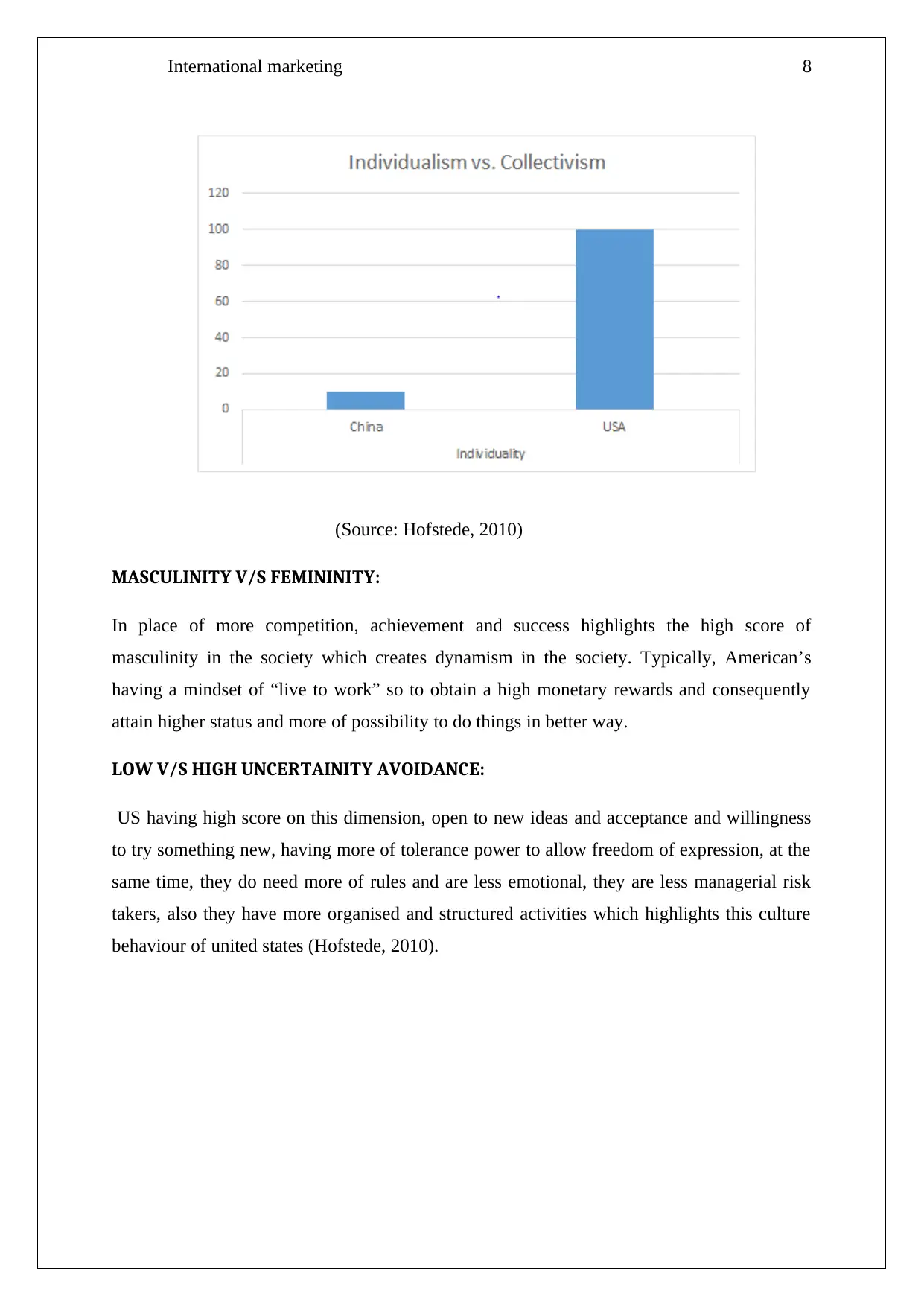
International marketing 8
(Source: Hofstede, 2010)
MASCULINITY V/S FEMININITY:
In place of more competition, achievement and success highlights the high score of
masculinity in the society which creates dynamism in the society. Typically, American’s
having a mindset of “live to work” so to obtain a high monetary rewards and consequently
attain higher status and more of possibility to do things in better way.
LOW V/S HIGH UNCERTAINITY AVOIDANCE:
US having high score on this dimension, open to new ideas and acceptance and willingness
to try something new, having more of tolerance power to allow freedom of expression, at the
same time, they do need more of rules and are less emotional, they are less managerial risk
takers, also they have more organised and structured activities which highlights this culture
behaviour of united states (Hofstede, 2010).
(Source: Hofstede, 2010)
MASCULINITY V/S FEMININITY:
In place of more competition, achievement and success highlights the high score of
masculinity in the society which creates dynamism in the society. Typically, American’s
having a mindset of “live to work” so to obtain a high monetary rewards and consequently
attain higher status and more of possibility to do things in better way.
LOW V/S HIGH UNCERTAINITY AVOIDANCE:
US having high score on this dimension, open to new ideas and acceptance and willingness
to try something new, having more of tolerance power to allow freedom of expression, at the
same time, they do need more of rules and are less emotional, they are less managerial risk
takers, also they have more organised and structured activities which highlights this culture
behaviour of united states (Hofstede, 2010).
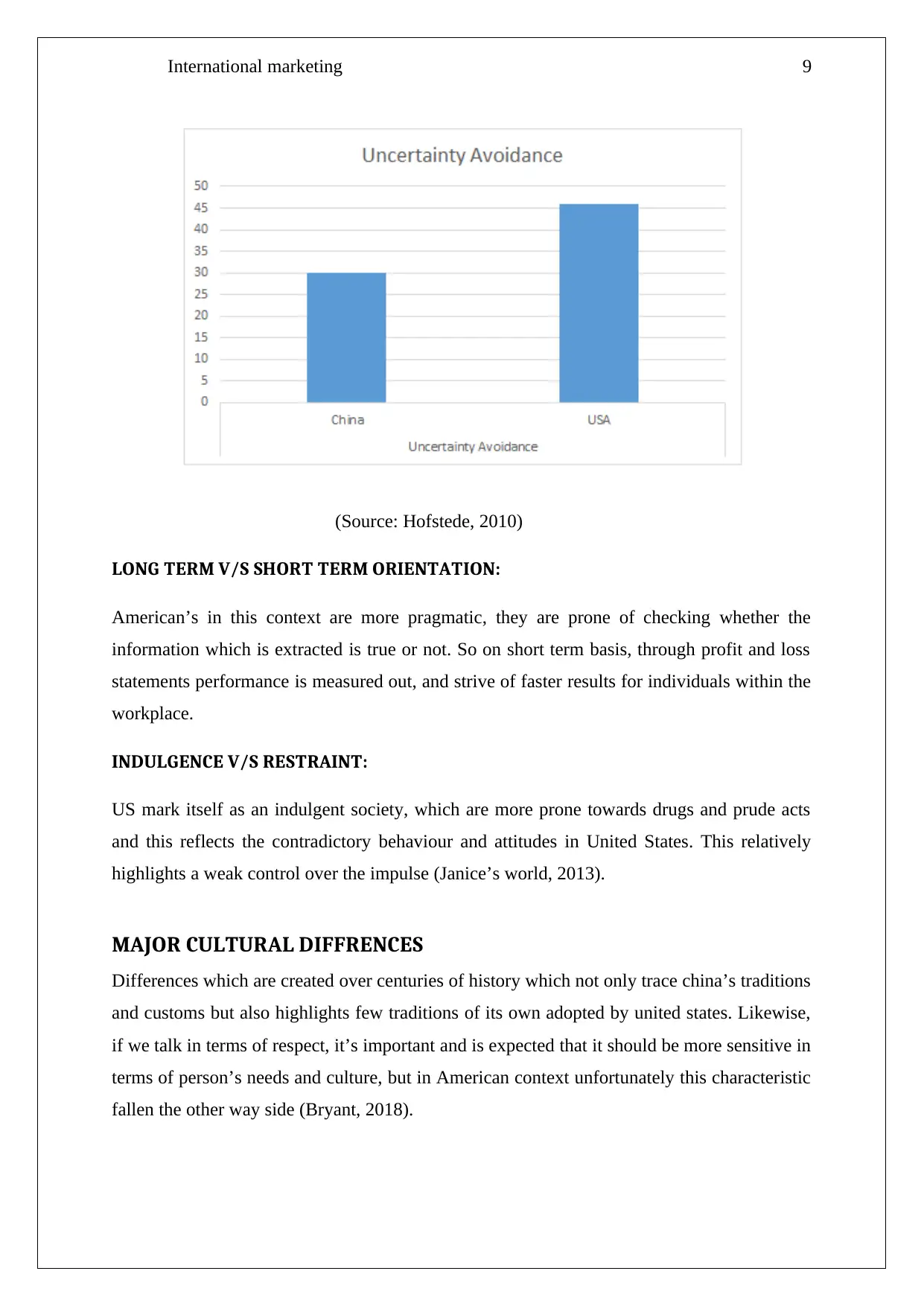
International marketing 9
(Source: Hofstede, 2010)
LONG TERM V/S SHORT TERM ORIENTATION:
American’s in this context are more pragmatic, they are prone of checking whether the
information which is extracted is true or not. So on short term basis, through profit and loss
statements performance is measured out, and strive of faster results for individuals within the
workplace.
INDULGENCE V/S RESTRAINT:
US mark itself as an indulgent society, which are more prone towards drugs and prude acts
and this reflects the contradictory behaviour and attitudes in United States. This relatively
highlights a weak control over the impulse (Janice’s world, 2013).
MAJOR CULTURAL DIFFRENCES
Differences which are created over centuries of history which not only trace china’s traditions
and customs but also highlights few traditions of its own adopted by united states. Likewise,
if we talk in terms of respect, it’s important and is expected that it should be more sensitive in
terms of person’s needs and culture, but in American context unfortunately this characteristic
fallen the other way side (Bryant, 2018).
(Source: Hofstede, 2010)
LONG TERM V/S SHORT TERM ORIENTATION:
American’s in this context are more pragmatic, they are prone of checking whether the
information which is extracted is true or not. So on short term basis, through profit and loss
statements performance is measured out, and strive of faster results for individuals within the
workplace.
INDULGENCE V/S RESTRAINT:
US mark itself as an indulgent society, which are more prone towards drugs and prude acts
and this reflects the contradictory behaviour and attitudes in United States. This relatively
highlights a weak control over the impulse (Janice’s world, 2013).
MAJOR CULTURAL DIFFRENCES
Differences which are created over centuries of history which not only trace china’s traditions
and customs but also highlights few traditions of its own adopted by united states. Likewise,
if we talk in terms of respect, it’s important and is expected that it should be more sensitive in
terms of person’s needs and culture, but in American context unfortunately this characteristic
fallen the other way side (Bryant, 2018).
Secure Best Marks with AI Grader
Need help grading? Try our AI Grader for instant feedback on your assignments.
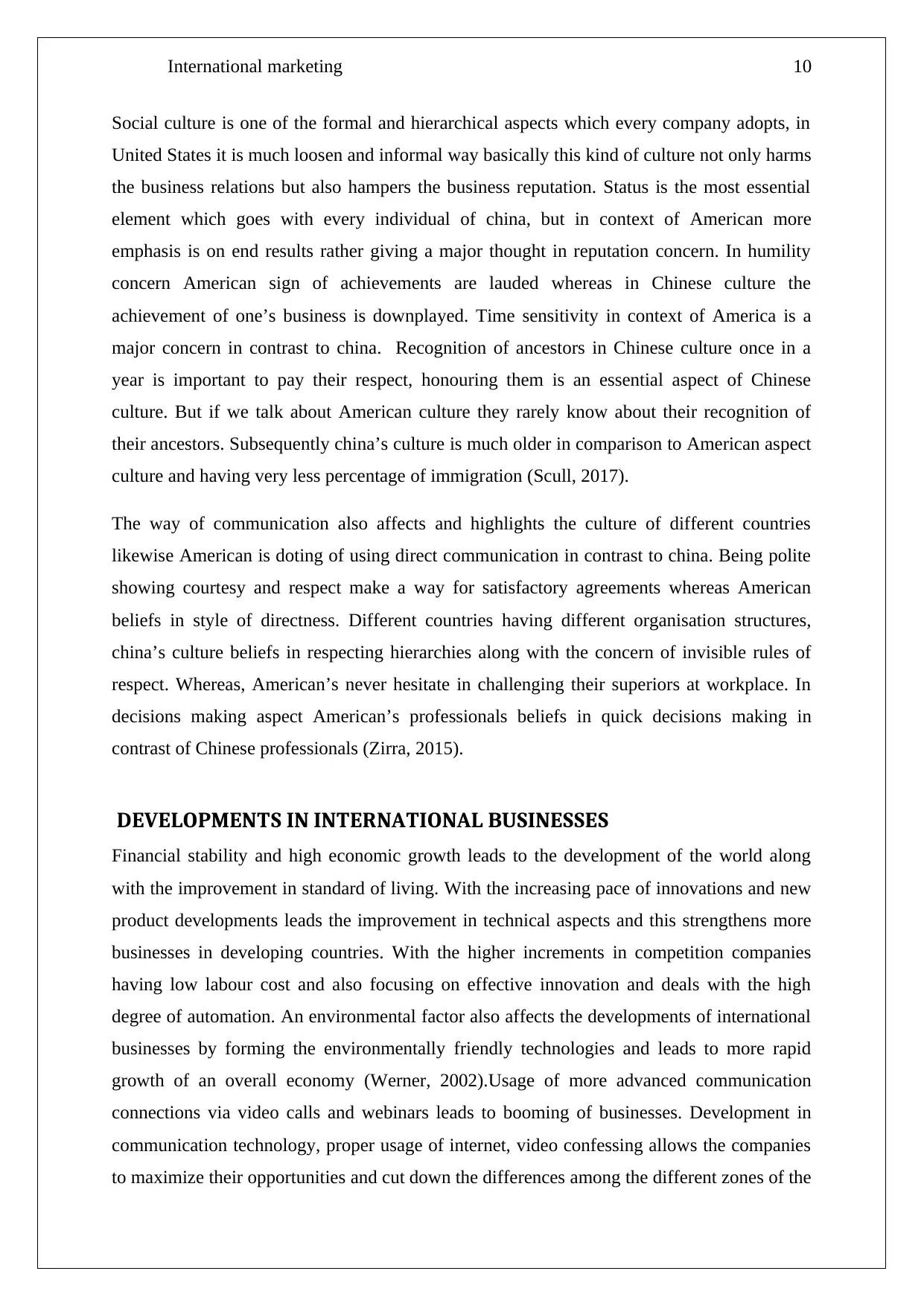
International marketing 10
Social culture is one of the formal and hierarchical aspects which every company adopts, in
United States it is much loosen and informal way basically this kind of culture not only harms
the business relations but also hampers the business reputation. Status is the most essential
element which goes with every individual of china, but in context of American more
emphasis is on end results rather giving a major thought in reputation concern. In humility
concern American sign of achievements are lauded whereas in Chinese culture the
achievement of one’s business is downplayed. Time sensitivity in context of America is a
major concern in contrast to china. Recognition of ancestors in Chinese culture once in a
year is important to pay their respect, honouring them is an essential aspect of Chinese
culture. But if we talk about American culture they rarely know about their recognition of
their ancestors. Subsequently china’s culture is much older in comparison to American aspect
culture and having very less percentage of immigration (Scull, 2017).
The way of communication also affects and highlights the culture of different countries
likewise American is doting of using direct communication in contrast to china. Being polite
showing courtesy and respect make a way for satisfactory agreements whereas American
beliefs in style of directness. Different countries having different organisation structures,
china’s culture beliefs in respecting hierarchies along with the concern of invisible rules of
respect. Whereas, American’s never hesitate in challenging their superiors at workplace. In
decisions making aspect American’s professionals beliefs in quick decisions making in
contrast of Chinese professionals (Zirra, 2015).
DEVELOPMENTS IN INTERNATIONAL BUSINESSES
Financial stability and high economic growth leads to the development of the world along
with the improvement in standard of living. With the increasing pace of innovations and new
product developments leads the improvement in technical aspects and this strengthens more
businesses in developing countries. With the higher increments in competition companies
having low labour cost and also focusing on effective innovation and deals with the high
degree of automation. An environmental factor also affects the developments of international
businesses by forming the environmentally friendly technologies and leads to more rapid
growth of an overall economy (Werner, 2002).Usage of more advanced communication
connections via video calls and webinars leads to booming of businesses. Development in
communication technology, proper usage of internet, video confessing allows the companies
to maximize their opportunities and cut down the differences among the different zones of the
Social culture is one of the formal and hierarchical aspects which every company adopts, in
United States it is much loosen and informal way basically this kind of culture not only harms
the business relations but also hampers the business reputation. Status is the most essential
element which goes with every individual of china, but in context of American more
emphasis is on end results rather giving a major thought in reputation concern. In humility
concern American sign of achievements are lauded whereas in Chinese culture the
achievement of one’s business is downplayed. Time sensitivity in context of America is a
major concern in contrast to china. Recognition of ancestors in Chinese culture once in a
year is important to pay their respect, honouring them is an essential aspect of Chinese
culture. But if we talk about American culture they rarely know about their recognition of
their ancestors. Subsequently china’s culture is much older in comparison to American aspect
culture and having very less percentage of immigration (Scull, 2017).
The way of communication also affects and highlights the culture of different countries
likewise American is doting of using direct communication in contrast to china. Being polite
showing courtesy and respect make a way for satisfactory agreements whereas American
beliefs in style of directness. Different countries having different organisation structures,
china’s culture beliefs in respecting hierarchies along with the concern of invisible rules of
respect. Whereas, American’s never hesitate in challenging their superiors at workplace. In
decisions making aspect American’s professionals beliefs in quick decisions making in
contrast of Chinese professionals (Zirra, 2015).
DEVELOPMENTS IN INTERNATIONAL BUSINESSES
Financial stability and high economic growth leads to the development of the world along
with the improvement in standard of living. With the increasing pace of innovations and new
product developments leads the improvement in technical aspects and this strengthens more
businesses in developing countries. With the higher increments in competition companies
having low labour cost and also focusing on effective innovation and deals with the high
degree of automation. An environmental factor also affects the developments of international
businesses by forming the environmentally friendly technologies and leads to more rapid
growth of an overall economy (Werner, 2002).Usage of more advanced communication
connections via video calls and webinars leads to booming of businesses. Development in
communication technology, proper usage of internet, video confessing allows the companies
to maximize their opportunities and cut down the differences among the different zones of the
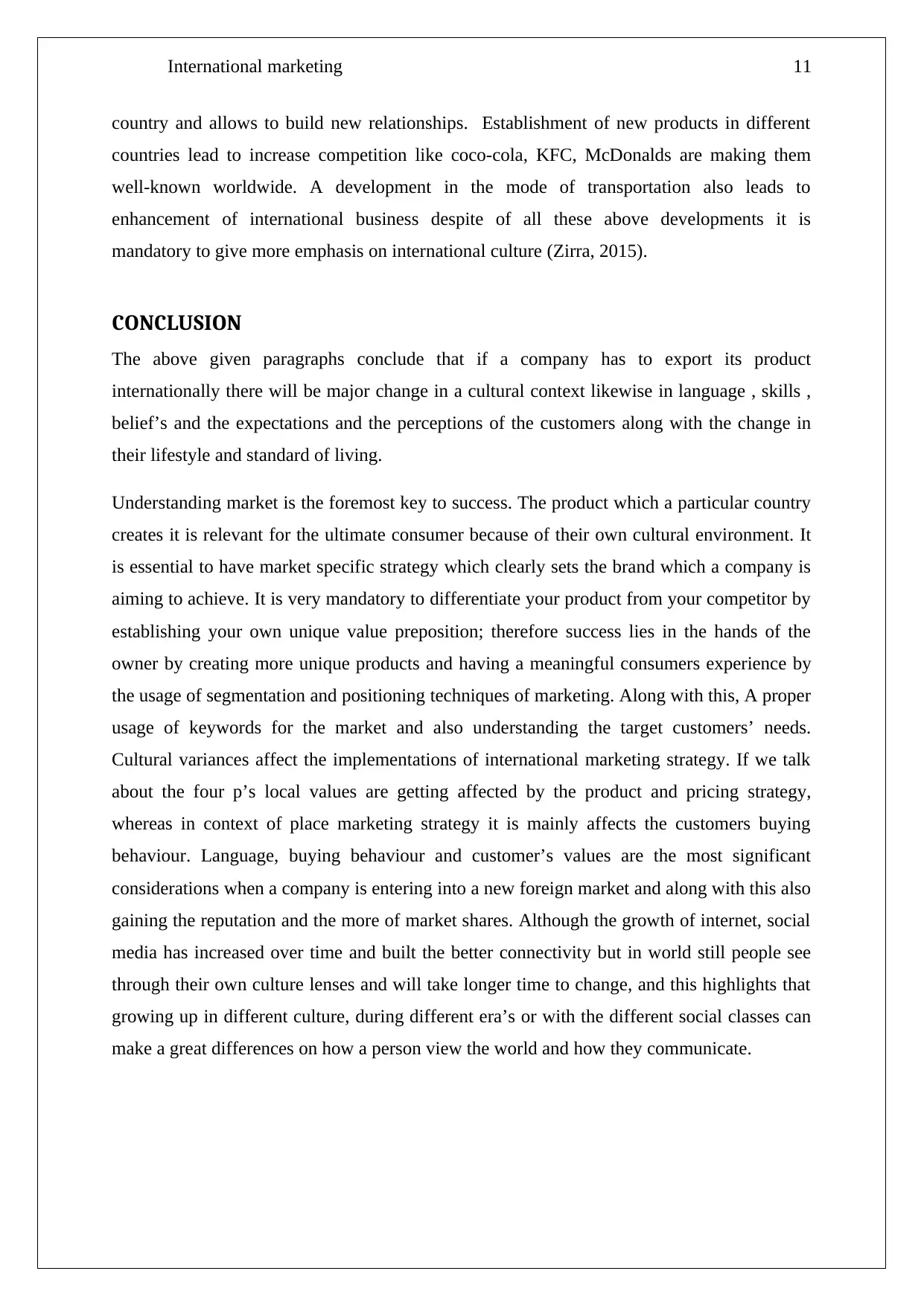
International marketing 11
country and allows to build new relationships. Establishment of new products in different
countries lead to increase competition like coco-cola, KFC, McDonalds are making them
well-known worldwide. A development in the mode of transportation also leads to
enhancement of international business despite of all these above developments it is
mandatory to give more emphasis on international culture (Zirra, 2015).
CONCLUSION
The above given paragraphs conclude that if a company has to export its product
internationally there will be major change in a cultural context likewise in language , skills ,
belief’s and the expectations and the perceptions of the customers along with the change in
their lifestyle and standard of living.
Understanding market is the foremost key to success. The product which a particular country
creates it is relevant for the ultimate consumer because of their own cultural environment. It
is essential to have market specific strategy which clearly sets the brand which a company is
aiming to achieve. It is very mandatory to differentiate your product from your competitor by
establishing your own unique value preposition; therefore success lies in the hands of the
owner by creating more unique products and having a meaningful consumers experience by
the usage of segmentation and positioning techniques of marketing. Along with this, A proper
usage of keywords for the market and also understanding the target customers’ needs.
Cultural variances affect the implementations of international marketing strategy. If we talk
about the four p’s local values are getting affected by the product and pricing strategy,
whereas in context of place marketing strategy it is mainly affects the customers buying
behaviour. Language, buying behaviour and customer’s values are the most significant
considerations when a company is entering into a new foreign market and along with this also
gaining the reputation and the more of market shares. Although the growth of internet, social
media has increased over time and built the better connectivity but in world still people see
through their own culture lenses and will take longer time to change, and this highlights that
growing up in different culture, during different era’s or with the different social classes can
make a great differences on how a person view the world and how they communicate.
country and allows to build new relationships. Establishment of new products in different
countries lead to increase competition like coco-cola, KFC, McDonalds are making them
well-known worldwide. A development in the mode of transportation also leads to
enhancement of international business despite of all these above developments it is
mandatory to give more emphasis on international culture (Zirra, 2015).
CONCLUSION
The above given paragraphs conclude that if a company has to export its product
internationally there will be major change in a cultural context likewise in language , skills ,
belief’s and the expectations and the perceptions of the customers along with the change in
their lifestyle and standard of living.
Understanding market is the foremost key to success. The product which a particular country
creates it is relevant for the ultimate consumer because of their own cultural environment. It
is essential to have market specific strategy which clearly sets the brand which a company is
aiming to achieve. It is very mandatory to differentiate your product from your competitor by
establishing your own unique value preposition; therefore success lies in the hands of the
owner by creating more unique products and having a meaningful consumers experience by
the usage of segmentation and positioning techniques of marketing. Along with this, A proper
usage of keywords for the market and also understanding the target customers’ needs.
Cultural variances affect the implementations of international marketing strategy. If we talk
about the four p’s local values are getting affected by the product and pricing strategy,
whereas in context of place marketing strategy it is mainly affects the customers buying
behaviour. Language, buying behaviour and customer’s values are the most significant
considerations when a company is entering into a new foreign market and along with this also
gaining the reputation and the more of market shares. Although the growth of internet, social
media has increased over time and built the better connectivity but in world still people see
through their own culture lenses and will take longer time to change, and this highlights that
growing up in different culture, during different era’s or with the different social classes can
make a great differences on how a person view the world and how they communicate.
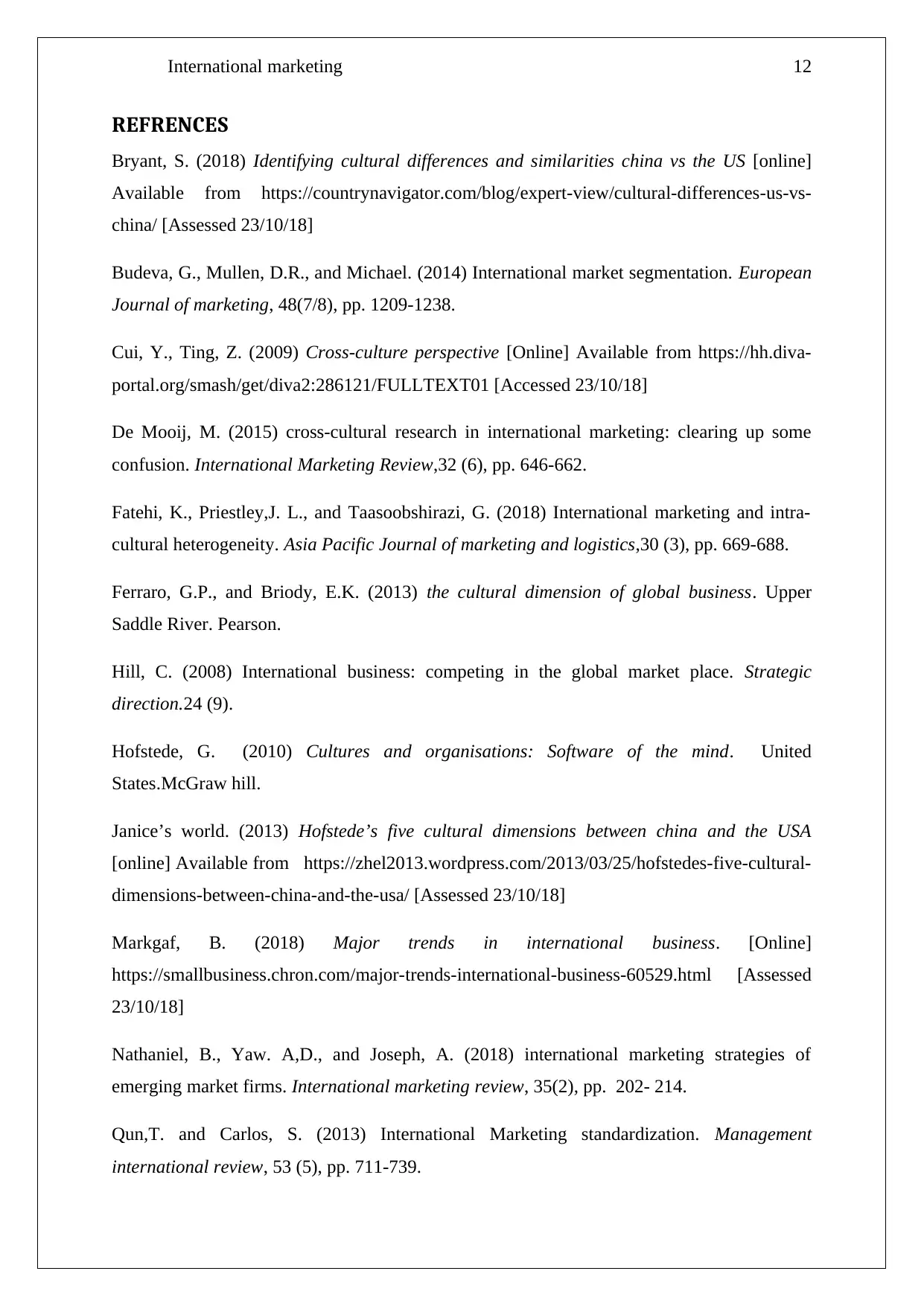
International marketing 12
REFRENCES
Bryant, S. (2018) Identifying cultural differences and similarities china vs the US [online]
Available from https://countrynavigator.com/blog/expert-view/cultural-differences-us-vs-
china/ [Assessed 23/10/18]
Budeva, G., Mullen, D.R., and Michael. (2014) International market segmentation. European
Journal of marketing, 48(7/8), pp. 1209-1238.
Cui, Y., Ting, Z. (2009) Cross-culture perspective [Online] Available from https://hh.diva-
portal.org/smash/get/diva2:286121/FULLTEXT01 [Accessed 23/10/18]
De Mooij, M. (2015) cross-cultural research in international marketing: clearing up some
confusion. International Marketing Review,32 (6), pp. 646-662.
Fatehi, K., Priestley,J. L., and Taasoobshirazi, G. (2018) International marketing and intra-
cultural heterogeneity. Asia Pacific Journal of marketing and logistics,30 (3), pp. 669-688.
Ferraro, G.P., and Briody, E.K. (2013) the cultural dimension of global business. Upper
Saddle River. Pearson.
Hill, C. (2008) International business: competing in the global market place. Strategic
direction.24 (9).
Hofstede, G. (2010) Cultures and organisations: Software of the mind. United
States.McGraw hill.
Janice’s world. (2013) Hofstede’s five cultural dimensions between china and the USA
[online] Available from https://zhel2013.wordpress.com/2013/03/25/hofstedes-five-cultural-
dimensions-between-china-and-the-usa/ [Assessed 23/10/18]
Markgaf, B. (2018) Major trends in international business. [Online]
https://smallbusiness.chron.com/major-trends-international-business-60529.html [Assessed
23/10/18]
Nathaniel, B., Yaw. A,D., and Joseph, A. (2018) international marketing strategies of
emerging market firms. International marketing review, 35(2), pp. 202- 214.
Qun,T. and Carlos, S. (2013) International Marketing standardization. Management
international review, 53 (5), pp. 711-739.
REFRENCES
Bryant, S. (2018) Identifying cultural differences and similarities china vs the US [online]
Available from https://countrynavigator.com/blog/expert-view/cultural-differences-us-vs-
china/ [Assessed 23/10/18]
Budeva, G., Mullen, D.R., and Michael. (2014) International market segmentation. European
Journal of marketing, 48(7/8), pp. 1209-1238.
Cui, Y., Ting, Z. (2009) Cross-culture perspective [Online] Available from https://hh.diva-
portal.org/smash/get/diva2:286121/FULLTEXT01 [Accessed 23/10/18]
De Mooij, M. (2015) cross-cultural research in international marketing: clearing up some
confusion. International Marketing Review,32 (6), pp. 646-662.
Fatehi, K., Priestley,J. L., and Taasoobshirazi, G. (2018) International marketing and intra-
cultural heterogeneity. Asia Pacific Journal of marketing and logistics,30 (3), pp. 669-688.
Ferraro, G.P., and Briody, E.K. (2013) the cultural dimension of global business. Upper
Saddle River. Pearson.
Hill, C. (2008) International business: competing in the global market place. Strategic
direction.24 (9).
Hofstede, G. (2010) Cultures and organisations: Software of the mind. United
States.McGraw hill.
Janice’s world. (2013) Hofstede’s five cultural dimensions between china and the USA
[online] Available from https://zhel2013.wordpress.com/2013/03/25/hofstedes-five-cultural-
dimensions-between-china-and-the-usa/ [Assessed 23/10/18]
Markgaf, B. (2018) Major trends in international business. [Online]
https://smallbusiness.chron.com/major-trends-international-business-60529.html [Assessed
23/10/18]
Nathaniel, B., Yaw. A,D., and Joseph, A. (2018) international marketing strategies of
emerging market firms. International marketing review, 35(2), pp. 202- 214.
Qun,T. and Carlos, S. (2013) International Marketing standardization. Management
international review, 53 (5), pp. 711-739.
Paraphrase This Document
Need a fresh take? Get an instant paraphrase of this document with our AI Paraphraser
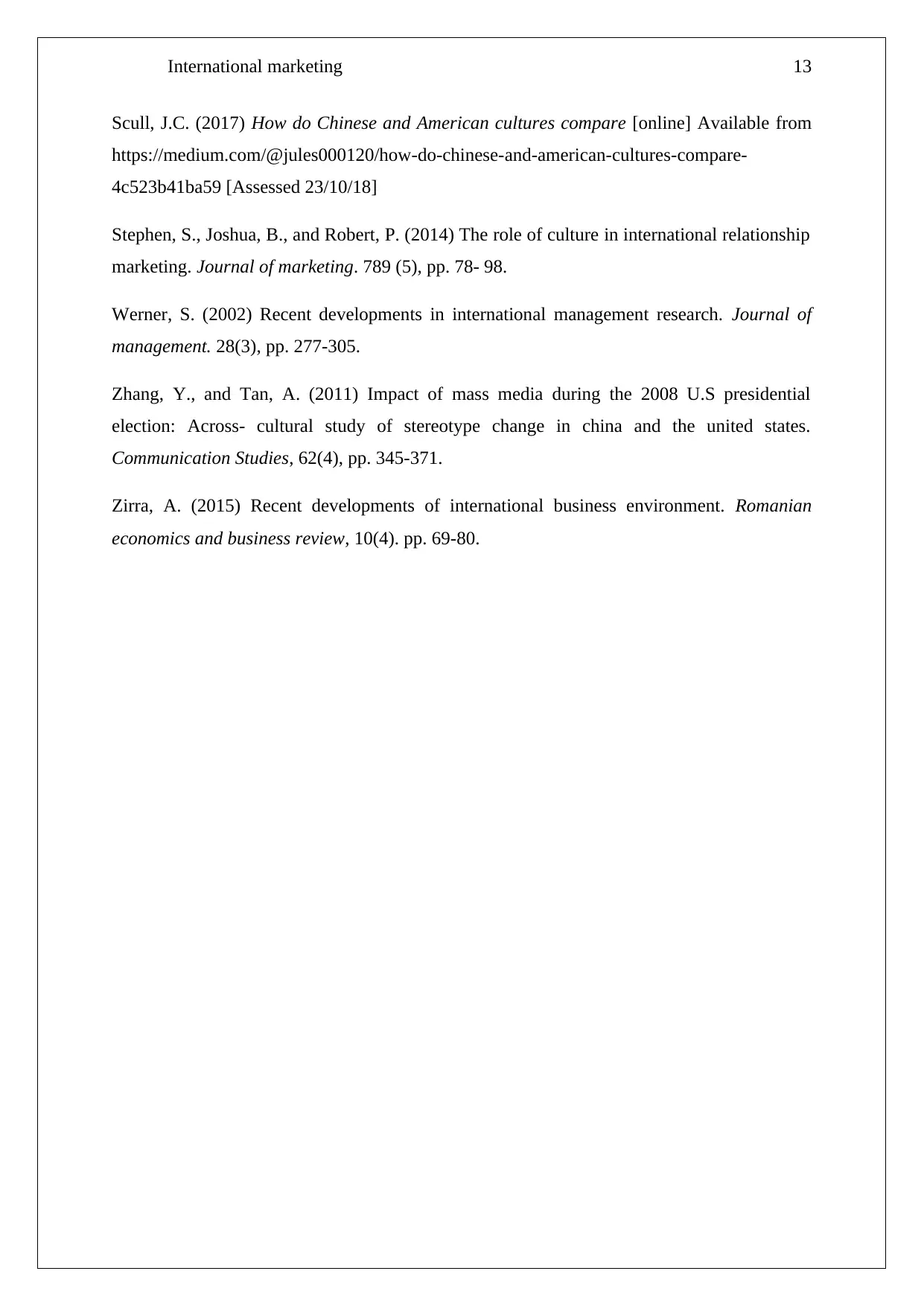
International marketing 13
Scull, J.C. (2017) How do Chinese and American cultures compare [online] Available from
https://medium.com/@jules000120/how-do-chinese-and-american-cultures-compare-
4c523b41ba59 [Assessed 23/10/18]
Stephen, S., Joshua, B., and Robert, P. (2014) The role of culture in international relationship
marketing. Journal of marketing. 789 (5), pp. 78- 98.
Werner, S. (2002) Recent developments in international management research. Journal of
management. 28(3), pp. 277-305.
Zhang, Y., and Tan, A. (2011) Impact of mass media during the 2008 U.S presidential
election: Across- cultural study of stereotype change in china and the united states.
Communication Studies, 62(4), pp. 345-371.
Zirra, A. (2015) Recent developments of international business environment. Romanian
economics and business review, 10(4). pp. 69-80.
Scull, J.C. (2017) How do Chinese and American cultures compare [online] Available from
https://medium.com/@jules000120/how-do-chinese-and-american-cultures-compare-
4c523b41ba59 [Assessed 23/10/18]
Stephen, S., Joshua, B., and Robert, P. (2014) The role of culture in international relationship
marketing. Journal of marketing. 789 (5), pp. 78- 98.
Werner, S. (2002) Recent developments in international management research. Journal of
management. 28(3), pp. 277-305.
Zhang, Y., and Tan, A. (2011) Impact of mass media during the 2008 U.S presidential
election: Across- cultural study of stereotype change in china and the united states.
Communication Studies, 62(4), pp. 345-371.
Zirra, A. (2015) Recent developments of international business environment. Romanian
economics and business review, 10(4). pp. 69-80.
1 out of 14
Related Documents
Your All-in-One AI-Powered Toolkit for Academic Success.
+13062052269
info@desklib.com
Available 24*7 on WhatsApp / Email
![[object Object]](/_next/static/media/star-bottom.7253800d.svg)
Unlock your academic potential
© 2024 | Zucol Services PVT LTD | All rights reserved.





